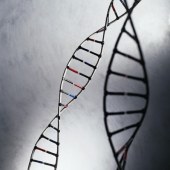
SUNDAY, Aug. 22 (HealthDay News) — For the first time, scientists have succeeded in isolating the lengthy protein encoded by the BRCA2 gene.
Dysfunction of this gene can up the risk for both breast and ovarian cancer.
By separating the protein from the rest of the components of human cells, researchers were able to study it more closely and figure out exactly what it does in the body.
“Since BRCA2 is such a large protein, it has a lot of different domains and it has never really been clear how the different domains work together,” explained Wolf-Dietrich Heyer, senior author of a paper appearing online in the journal Nature Structural & Molecular Biology and co-leader of the Molecular Oncology Program at the University of California, Davis, Cancer Center.
“With having the entire protein purified now, one has a chance to actually understand the whole protein,” he said. “It’s a huge protein. People were studying individual pieces but never got the full picture. Now we can really start to analyze its mechanisms.”
That analysis should help illuminate the underpinnings of breast and ovarian cancers and point the way, someday, to better prevention and treatment.
Heyer’s paper joins two other papers, one also in Nature Structural & Molecular Biology and one in Nature, which detail the findings. All were published online Aug. 22.
Although the BRCA1 and BRCA2 genes were discovered some 15 years ago, scientists have had trouble deciphering their inner workings.
“Everybody has a BRCA gene. You need it because it functions as a tumor-suppressor gene,” explained Dr. Julia Smith, director of the Breast Cancer Screening and Prevention Program at NYU Cancer Institute in New York City. “Abnormal cells that could become tumor cells are popping up all the time and we have lots and lots of repair mechanisms and corrective mechanisms to bump off those cells so they can’t divide and behave badly.”
Under normal circumstances, the BRCA gene would automatically correct those problems.
“But if you have certain mutations in the BRCA gene, then one of the mechanisms of repair – the BRCA gene – is not functioning properly, so that cell is allowed to proliferate and grow out of control,” Smith said.
Over the course of several, often frustrating years, these scientists were able to purify the protein, which consists of 3,418 amino acids, to reveal some of its inner workings.
As it turns out, BRCA2 binds with another protein, RAD51, in a specific way to make sure that any breaks in the DNA get fixed correctly.
“It’s a basic science discovery but it has many implications,” said Stephen Kowalczykowski, senior author of the paper appearing in Nature and distinguished professor of microbiology and molecular and cellular biology at the University of California, Davis. “One would be that since we now know how the protein works, we can try to screen for therapeutic agents that could mitigate some of these problems.”
“This illuminates a function of BRCA2 that’s going to give new ideas to people who are involved in translational [lab-to-bedside] work,” added Dr. Priscilla A. Furth, a professor of oncology and medicine at Lombardi Cancer Center of Georgetown University in Washington, D.C. “This is good, solid, basic science that is going to put us on a firm ground as we now look at why we get cancers from the loss of BRCA2.”
“The more we can understand where the defect is the more we can try to correct it. RAD51 could be a molecule that we could target to make DNA repair actually effective in BRCA patients,” Smith added. “That’s the import of this work. It’s not going to help us right now but we’re moving more and more towards targeted therapy, designing treatments that target specific molecular abnormalities.”
More information
There’s more on BRCA1 and BRCA2 at the U.S. National Cancer Institute.

